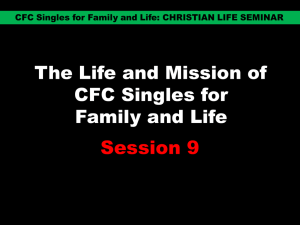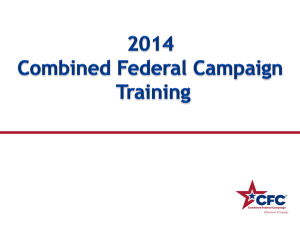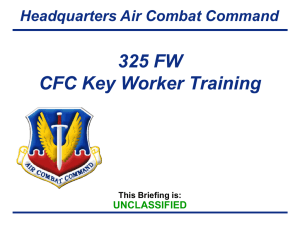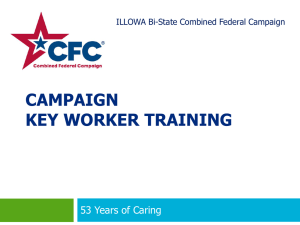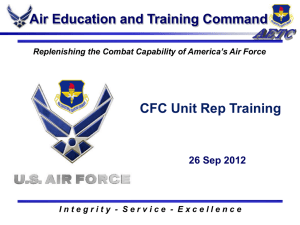CHIDMS1-2864073-v1-TEI_-_Repatriation_Planning_(Kalamazoo)
advertisement
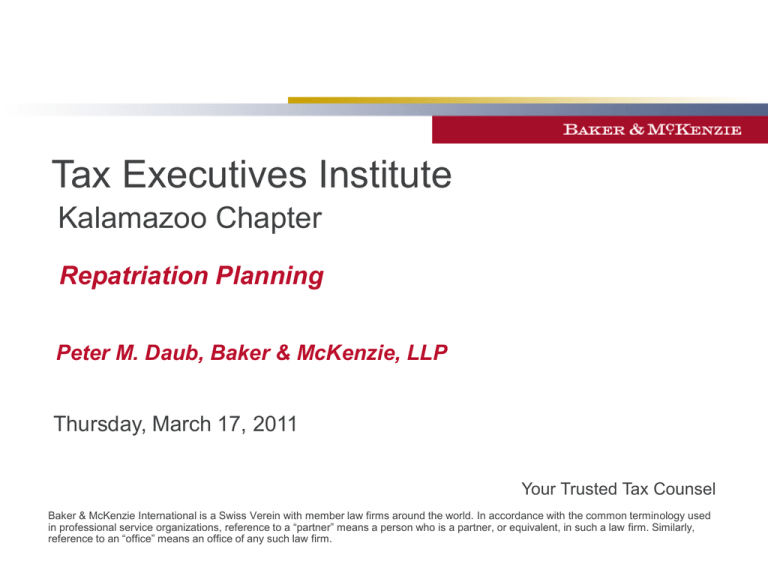
Tax Executives Institute Kalamazoo Chapter Repatriation Planning Peter M. Daub, Baker & McKenzie, LLP Thursday, March 17, 2011 Your Trusted Tax Counsel Baker & McKenzie International is a Swiss Verein with member law firms around the world. In accordance with the common terminology used in professional service organizations, reference to a “partner” means a person who is a partner, or equivalent, in such a law firm. Similarly, reference to an “office” means an office of any such law firm. Presenter Peter M. Daub (Washington, D.C.) peter.daub@bakermckenzie.com (202) 452-7081 2 AGENDA • • • • • • • • • • • • Defining the Repatriation Problem Restructuring to Avoid Anti-Hopscotch Prepayment Strategies Return of Capital Distributions All Cash “D” Reorganizations Section 368(a)(2)(D) Reorganization of Domestic Target Outbound “F” Reorganization of Domestic Target Purchase of Parent Stock Used in Foreign Acquistion Stock Compensation Strategies Transfer Pricing Approaches Dueling Loans Rate Hyping 3 Defining the Repatriation Problem • For those companies that are not in an overall foreign loss (OFL) position, the issue is typically how to get access to low-tax cash without: Incurring a significant residual U.S. tax liability; and Violating the company’s APB 23 assumption • For those companies in an OFL, the objective may be to get access to low-tax or high tax cash without significant residual tax or violating APB 23 assumption 4 Restructuring to Avoid Anti-Hopscotch -- Section 304 Transactions and Other Internal Restructurings • When Anytime (under current law) • How Section 304 Transaction to hopscotch low-tax E&P pools over high tax pools, or vice versa Spin-offs and other internal restructurings • Why Need longer-term solution that warrants restructuring 5 Restructuring to Avoid Anti-Hopscotch Example -Section 304 Transaction Advantages – Section 304 deemed dividend from CFC-2 earnings direct to US parent U.S. Parent – No GRA needed. Treas. Reg. §1.367(a)9T However… CFC-1 (Low-tax) – Dividend constrained by value of CFC-3 CFC-3 $ – CFC-2 may not be desirable holdco Variations CFC-2 (High-tax) CFC-3 shares – Sell CFC-1 stock to CFC-2 – CFC-3 sells other CFC shares to CFC-1 – Recap shares of transferred CFC into preferred to minimize valuation issues 6 Restructuring to Avoid Anti-Hopscotch Internal Foreign-to-Foreign Inversion Steps – US contributes LT CFC stock to HT CFC Hold Co in exchange for HT CFC Hold Co common and preferred stock – Dividends on preferred stock can be paid directly to US without distribution to LT CFC Before After US US common and preferred stock LT CFC Hook stock Key Points – Foreign-to-foreign section 351 exchange or “B” reorganization – Need GRA HT CFC Hold Co HT CFC Hold Co LT CFC HT CFCs – Need business purpose – Valuation considerations – Can be long term solution HT CFCs 7 Restructuring to Avoid Anti-Hopscotch Spin-off of High Tax Group Steps US – LT CFC distributes stock of HT CFC Holdco to US HT CFC Holdco stock Key Points – Can qualify as tax free section 355 spin-off LTC CFC – Need business purpose – No GRA or e&p pick-up – Most elegant long term solution HT CFC Hold Co HT CFCs 8 Prepayment Strategy Inventory Prepayment Transaction USCO Cash equal to two years’ worth of inventory, discounted to reflect the fact that the money is advanced earlier than normal Must be nonrefundable Swiss Subsidiary 9 Prepayment Strategy Broader Prepayment Issues • Can be used for inventory, services, royalties and cost sharing payments • Can USCO defer the income pursuant to Treas. Reg. § 1.451-5 or Rev. Proc. 2004-34? • If deferral is possible, how long? Could immediate income be a benefit? • Is the discount that foreign subsidiary receives subpart F income or is it a reduction in expense? • Can you repeat? 10 Return of Capital Distribution US Parent return of capital distribution 12/30/Y1 cash loan 12/28/Y1 Third Party Lender Foreign Holdco repay loan with cash on 1/2/Y2 cash dividend 1/2/Y2 Foreign Sub Buyer sale of assets 1/1/Y2 11 Return of Capital Distribution • Can IRS assert subsequent distribution really boot in the section 351 transaction in which new Foreign Holdco formed? • Could the return of capital distribution trigger any GRAs entered into on the set up? • Will the bank demand a parent guarantee or pledge of subsidiary assets to support the loan? 12 All-Cash “D” Reorganization Value $100 Basis $ 80 E&P / Section 1248 Amt. $ 20 USCO OPCO (Country X) Holding Company (Dutch) effective rate in pool of 35% OPCO (Ireland) OPCO’s attributes are key to ensuring this structure works low-tax earnings 13 All-Cash “D” Reorganization Value $100 Basis $ 80 E&P / Section 1248 Amt. $ 20 USCO OPCO c/s for $100 note OPCO (Country X) Holding Company (Dutch) dividends to Holdco to pay off note effective rate in pool of 35% Consequences – $80 recovery of basis – $20 OPCO (X) e&p pick-up OPCO (Country X) OPCO (Ireland) CTB election 14 Section 368(a)(2)(D) Reorganization of Domestic Target US Parent (US) merger consideration 40% FA stock and 60% cash merger consideration of FA stock and cash Target (US) FA (Non-US) merger US Sub (US) • Assume US Parent has a full FMV basis in the shares of Target 15 Section 368(a)(2)(D) Reorganization Issues • Outside the scope of Notice 2008-10 because it is a section 361 transfer from one US corporation to another US corporation • Cash boot can be received tax-free by US Parent because there is no gain in the shares of Target 16 Outbound “F” Reorganization of Domestic Target • Convert recently acquired/purchased U.S. target into a foreign company • Allows repatriation of pre-acquisition E&P via DRD DRD available because the earnings have already been subject to US tax • Allows repatriation through return of capital/basis High/FMV basis in recently purchased entity • Target must repatriate cash before new low taxed earnings accrue in the foreign target Must manage the E&P pools Must fund the distribution 17 Outbound “F” Reorganization of Domestic Target (Cont.) • Key Costs Basis step down for the built-in gain in the tangible assets (but not the IP) DRD at 80% or 100%? Potential waiting period under section 1059 • Issues arising from the US tangible assets Dividend them up and recognize section 311(b) gain and related issues, OR Live with two separate U.S. tax returns 18 Outbound “F” Reorg. Example – Step 1 US Parent Target Shareholders cash Third Party Bank Debt? Merger Sub (US) Target (US) merge Target CFCs • Assume that most appreciation is in Target intangibles or CFCs, not US operating assets US Tax Consequences • Treated as a taxable stock purchase • US Parent takes a full FMV basis in the target stock 19 Outbound “F” Reorg. Example – Steps 2 and 3 US Parent shares of Target Foreign Newco Target LLC Conversion to LLC (deemed liquidation) Target CFCs US Tax Consequences • Treated as an outbound “F” reorganization 20 Outbound “F” Reorg. Example – Step 4 US Parent Foreign Newco IP and CFC shares Target LLC Target CFCs 21 Outbound “F” Reorg. Example – Step 5 • Foreign Newco contributes Target LLC to US Newco • US Newco assumes Target LLC liabilities such that Foreign Newco takes a $0 stock basis in US US Parent (US) • to avoid section 956 Foreign Newco US Newco Target CFCs Target LLC 22 Purchase of Parent Stock Used in Foreign Acquisition Key Points – CFC purchase of new Parent stock non-taxable under section 1032 Parent Shareholders – CFC use of Parent stock in acquisition triggers no gain due to FMV basis – Anti-"killer B" Notices not applicable if no tax-free reorganization Parent Stock $ Target Stock CFC Parent Stock Foreign Target Foreign Target 23 Stock Compensation Strategies • Foreign Sub grants stock options to its employees • US Parent provides stock to Foreign Sub’s employees • Foreign Sub reimburses US Parent for difference between FMV of stock and employee payment • PLR 200430026 concludes the reimbursement is not a dividend to extent of section 83 spread • Questions Is an advance agreement to reimburse required? GAAP implications? 24 Transfer Pricing Approaches • Consider expanding scope of expense charge-outs If can get foreign deduction E.g., stewardship expense, guarantee fees • IP ownership • Consider prepayments of royalties, service fees, cost sharing payments, inventory purchases Does not impact basic transfer pricing approach, but … Need to reflect risk factor and time value of money Discount rate versus bond rate versus AFR Is discount above or below the line? • Rev. Proc. 99-32 repatriation of agreed section 482 adjustments 25 Dueling Loan Strategy USCO 2A 1B 2B 1A CFC OPCO 1 (Low-Tax) 12/31 Year end 11/30 Year end CFC OPCO 2 (Low-Tax) 26 Dueling Loan Strategy • OPCO 2 will have an 11/30 year end, as permitted under section 898 of the Code. The low-tax partners will lend all of their cash back to the United States parent at the following intervals: OPCO One – – – – – – – – 12/01/03-01/14/04 01/15/04-02/28/04 03/01/04-04/14/04 04/15/04-05/31/04 06/01/04-07/14/04 07/15/04-08/30/04 09/01/04-10/14/04 10/15/04-11/31/04 OPCO Two X X X X X X X X 27 Dueling Loan Strategy • Potential risks: Debt v. Equity – unlikely to be successful, provided loans are repaid on time and advances have the formal indicia of debt. Step-Transaction – at what point will a reviewing court step the advances together and treat them as one loan? – Rev. Rul. 89-73, 1989-1 C.B. 258 (2 months not ok, but 6 months ok) – Jacob’s Engineering v. Commissioner, 97-1 USTC ¶50,340 (C.D. Cal. 1997), aff’d 99-1 USTC ¶50,335 (9th Cir. 1999). Reg § 1.956 – IT(b)(4) Section 269 Conduit Section 7701 (o) 28 Rate-Hyping Example 1. USCO has $100 of U.S. Source Income and $100 of Foreign Source Income subject to $0 of foreign tax Example 2. Same as 1, but USCO triggers a $100 foreign source dividend subject to $70 of foreign tax credits Income $200 Income $300 Tentative U.S. Tax $ 70 Tentative U.S. Tax $105 Tentative FTC Section 904 Limitation FTC $ 0 $35 * Tentative FTC Section 904 Limitation FTC $70 $70 * Total U.S. Tax ($ 0) $ 70 * Assumes all foreign source income is in the general basket Total U.S. Tax ($70) $ 35 * Assumes all foreign source income is in the general basket OBJECTIVE: MOVE FROM EXAMPLE 1 to EXAMPLE 2 WITHOUT PAYING MORE FOREIGN TAX 29 Rate-Hyping USCO CFC 1 Stock Contributed CFC 1 <$70 Deficit> CFC 2 $70 E&P $30 Taxes CFC 1 <$70 Deficit> 30 Hovering – Rate Hyping EXAMPLE: CFC2 acquires all of the assets of a CFC 1 in a tax-free transaction on December 31, 2001. Each has the following attributes as of December 31, 2006: Acquirer Target Pool E&P Taxes Pool E&P General Basket $ 70 $ 30 General Basket ($70) Taxes $ 0 Assume the Surviving Corporation is a CFC, the attributes carry over as follows: (Hovering) (Hovering) Pool E&P Taxes (Deficit) (Taxes) General Basket $ 70 $ 30 ($ 70) ($0) If Surviving Corporation earns another $100 in 2007, subject to $30 of taxes, the $100 will be eaten up by $100 of hovering deficit. Pool General Basket E&P $ 70 Taxes $ 60 (Hovering) (Hovering) (Deficit) (Taxes) ($0) ($0) If, in 2008, Surviving Corporation does not earn any net income, and a $100 dividend is declared, it will bring with it $60 of taxes, a 46% effective rate. 31

